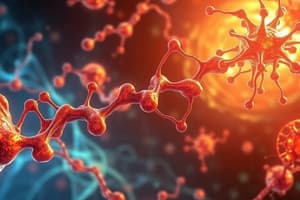Podcast
Questions and Answers
¿Cuál de los siguientes es un producto clave del ciclo de Krebs?
¿Cuál de los siguientes es un producto clave del ciclo de Krebs?
- Glucosa
- Ácido láctico
- Piruvato
- CO2 (correct)
La fosforilación oxidativa es un proceso que:
La fosforilación oxidativa es un proceso que:
- Utiliza la energía almacenada en los gradientes de protones para sintetizar ATP (correct)
- Genera ATP mediante la descomposición de la glucosa en glucólisis
- Convierte piruvato en acetil-CoA
- Utiliza energía lumínica para sintetizar ATP
¿Dónde ocurre la fosforilación oxidativa en la célula?
¿Dónde ocurre la fosforilación oxidativa en la célula?
- En la membrana interna de las mitocondrias (correct)
- En el núcleo
- En el citoplasma
- En la membrana plasmática
La cadena de transporte de electrones se encuentra en:
La cadena de transporte de electrones se encuentra en:
¿Cuál es el aceptor final de electrones en la cadena de transporte electrónico?
¿Cuál es el aceptor final de electrones en la cadena de transporte electrónico?
El ciclo de Krebs se inicia con la reacción de:
El ciclo de Krebs se inicia con la reacción de:
¿Cuál de las siguientes moléculas se regenera al final del ciclo de Krebs?
¿Cuál de las siguientes moléculas se regenera al final del ciclo de Krebs?
La energía liberada por la cadena de transporte de electrones se utiliza para:
La energía liberada por la cadena de transporte de electrones se utiliza para:
Flashcards
Rutas Anabólicas
Rutas Anabólicas
Son rutas biosintéticas que crean moléculas complejas a partir de moléculas más simples.
Ciclo del Ácido Cítrico
Ciclo del Ácido Cítrico
Serie de reacciones enzimáticas que oxidan acetil-CoA y generan energía.
Fase de Oxidación
Fase de Oxidación
Metabolismo donde NADH y FADH2 se oxidan para producir ATP.
Cadena de Transporte de Electrones
Cadena de Transporte de Electrones
Signup and view all the flashcards
Protones (H+)
Protones (H+)
Signup and view all the flashcards
ATP Sintasa
ATP Sintasa
Signup and view all the flashcards
NADH y FADH2
NADH y FADH2
Signup and view all the flashcards
Oxaloacetato
Oxaloacetato
Signup and view all the flashcards
Study Notes
Anabolic Pathways
- Anabolic pathways are biosynthetic pathways that build complex molecules from simpler ones.
- They generally require energy input, often in the form of ATP.
- Examples include protein synthesis, DNA replication, and the synthesis of carbohydrates and lipids.
- They are crucial for growth, repair, and maintenance of the organism.
- Anabolic pathways are often regulated to maintain homeostasis.
Citric Acid Cycle (Krebs Cycle)
- The Krebs cycle is a series of enzyme-catalyzed reactions that occur in the mitochondrial matrix.
- It is the central metabolic pathway for oxidizing acetyl-CoA derived from carbohydrates, fats, and proteins.
- The cycle generates reducing equivalents (NADH and FADH2), ATP, and intermediates for other metabolic pathways.
- It's a crucial part of cellular respiration, providing energy and building blocks.
- Key products include CO2, ATP, NADH, and FADH2.
- The cycle regenerates the starting molecule, oxaloacetate, allowing for continuous operation.
- The cycle starts and ends with the 4-carbon molecule oxaloacetate.
Oxidative Phosphorylation
- This is a metabolic pathway where energy from the oxidation of NADH and FADH2 is used to generate ATP.
- It occurs in the inner mitochondrial membrane.
- The process involves a series of redox reactions, generating a proton gradient across the inner mitochondrial membrane.
- Electron transport chains are a key part of this process.
- Oxidative phosphorylation accounts for most of the ATP synthesis in aerobic organisms.
Electron Transport Chain
- The electron transport chain (ETC) is a series of protein complexes embedded in the inner mitochondrial membrane.
- It uses the electrons carried by NADH and FADH2 to pump protons (H+) across the membrane, creating a proton gradient.
- This gradient drives ATP synthase, an enzyme that generates ATP from ADP and inorganic phosphate.
- The final electron acceptor in the chain is oxygen, forming water.
- The ETC is essential for efficient energy extraction from nutrients.
- The complexes in the ETC transfer electrons stepwise through different redox couples generating energy.
- The flow of electrons along the chain is exergonic, releasing energy that drives protons across the membrane.
Studying That Suits You
Use AI to generate personalized quizzes and flashcards to suit your learning preferences.




